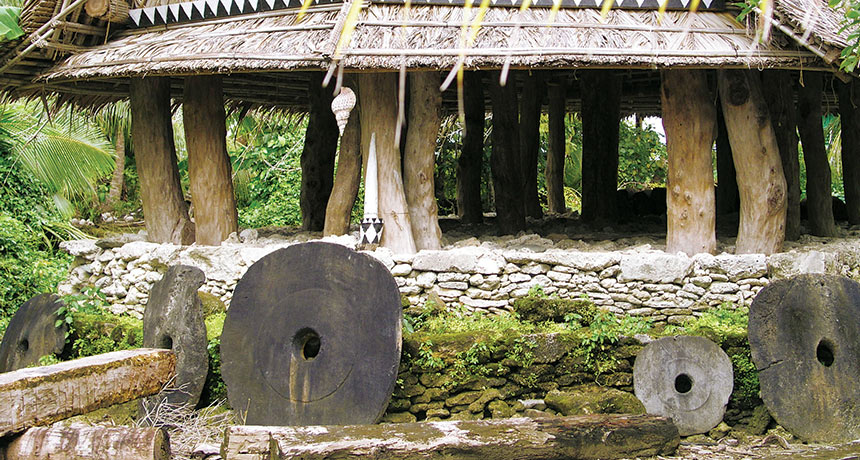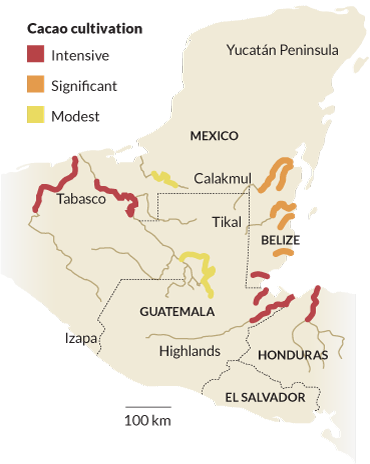Conflict reigns over the history and origins of money
Thousands of years ago, money was a means of debt payment, archaeologists and anthropologists say
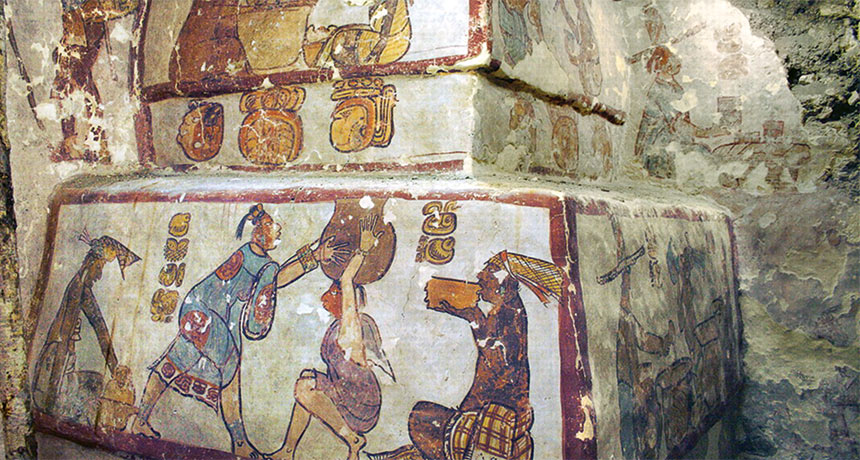
MONEY MYSTERIES Painted murals found in a small pyramid at the Classic Maya site of Calakmul depict scenes of people exchanging and consuming goods in what may have been a marketplace. Stylistic details indicate that the images date to nearly 1,400 years ago.
R. Carrasco Vargas, V.A. Vázquez López and S. Martin/PNAS 2009
Wherever you go, money talks. And it has for a long time.
Sadly, though, money has been mum about its origins. For such a central element of our lives, money’s ancient roots and the reasons for its invention are unclear.
As cryptocurrencies such as Bitcoin multiply into a flock of digital apparitions, researchers are still battling over how and where money came to be. And some draw fascinating parallels between the latest, buzzworthy cryptocurrencies, which require only a virtual wallet, and a type of money developed by one Micronesian island community that wouldn’t fit in anyone’s wallet, pocket or purse.
When it comes to money’s origins, though, conflict reigns. Economists have held one view of money’s origins for hundreds of years. But a growing number of anthropologists and archaeologists, holding a revisionist view, say that economists’ standard story is bankrupt.
Economists and revisionists alike agree that an object defined as money works in four ways: First, it serves as a means for exchanging goods and services. Currency enables payment of debts. It represents a general measure of value, making it possible to calculate prices of all sorts of items. And, finally, money can be stored as a wealth reserve.
From there, the two groups split. Mainstream economists assume that bartering of goods and services inspired money’s invention. Anthropologists and archaeologists contend that early states invented currency as a means of debt payment.
“Much academic work assumes that [monetary systems] arose in nation-states within the last 200 to 400 years,” says sociocultural anthropologist Daniel Souleles of Copenhagen Business School in Frederiksberg. But financialized transactions and debt show up in lots of places much further back in time.
Recent research from the Americas adds new questions to the debate. These investigations suggest that money independently appeared for different reasons and assumed different tangible forms in many parts of the world, starting thousands of years ago.
Debt bet
Since the 1776 publication of Adam Smith’s The Wealth of Nations, a consensus among economists has held that people’s self-interested trading decisions automatically balance supply and demand with little or no need for government involvement. A natural human tendency to barter one product for another, say potatoes for pottery, led to the invention of money in ancient Eurasian states, economists hold.
That well-worn story gets money all wrong, anthropologists and archaeologists say. “Adam Smith based his ‘creation myth’ of financial systems on ignorance of what actually happened in the past,” says archaeologist Robert Rosenswig of the University at Albany in New York.
Early governments created money to pay off public works debts and to collect taxes, Rosenswig contends. Bartering had nothing to do with it. Instead, money grew out of older systems of credit and debt, which anthropologists have documented for more than a century. In small-scale societies, debts concern obligations to others. Among hunter-gatherer and farming groups, for example, daughters given away in marriage create debts that are partially repaid with goods known as bridewealth. Full repayment requires that the recipient of the first bride provide a bride in return. No cash needed.
Revisionists argue that a transition to a new form of money-friendly debt started at least 5,500 years ago in the agricultural states of Mesopotamia and Egypt. In Mesopotamia, the silver shekel — a lump of metal, not a coin — was a basic monetary measure. Rulers decreed that one shekel’s weight in silver was equivalent to a bushel of barley. Shekels of silver, gold and other metals were used in other ancient societies. Precise weights of shekels appear to have varied and are difficult to pin down. Farmers were taxed to support royal lifestyles and public works. What the farmers and other commoners couldn’t pay in goods was recorded as debt in shekels. Merchants and tradespeople acquired goods from temple and palace officials on credit.
Mesopotamia-era merchants traveling through Eurasia may have used chunks of silver, measured in roughly standardized shekels, to pay for some transactions. But whether those lumps of silver could settle debts is unknown.
Coins stamped with images of animals or rulers, guaranteeing the metal’s value, first appeared in the kingdom of Lydia, in what’s now Turkey, around 2,600 years ago. Soon after, cities and states in Greece, Persia, India and China began to strike their own coins. From the start, coins funded armies and wars of conquest. In the process, coins became legal tender for all sorts of transactions. Marketplaces were a result of this system, not its cause, revisionists argue.
David Graeber, an anthropologist at the London School of Economics and Political Science, laid out this alternative view in his 2011 book Debt: The First 5,000 Years.
Graeber relied mainly on evidence from African, Asian and European societies. But his book has inspired a growing line of research into money’s murky origins in the Americas. Many of those investigators met to discuss their findings in April in Washington, D.C., at the Society for American Archaeology’s annual meeting.
Some see Graeber’s focus on debt as vital to understanding when and how the ancient Maya and nearby societies transformed goods, such as cacao beans and woven cotton, into currencies. But bartering can’t be ruled out as a precursor of perishable payments in those same societies. For now, there are more questions than answers.
“Debt played a huge role in ancient Central America and Mexico, but it’s not clear how currencies emerged there,” says anthropological archaeologist Joanne Baron of Bard High School Early College in Newark, N.J.
Maya markets
In the 1500s, Spaniards wrote of observing a thriving system of marketplaces in societies stretching from Mexico to Central America, including the Aztecs and the Maya. Spanish chroniclers described currencies, most prominently cacao beans and woven cloth, that were widely used to buy goods, pay taxes and debts, calculate monetary values and store family wealth.
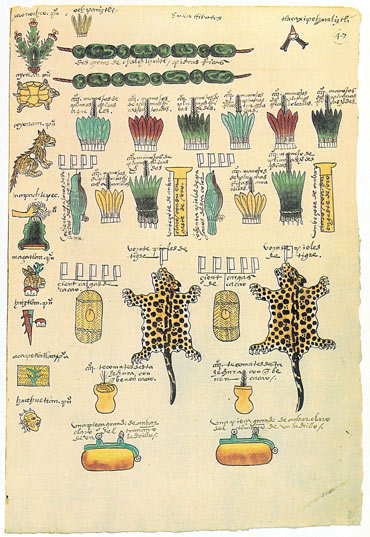
Researchers have long suspected that Maya marketplaces and merchants plus various goods used as currencies appeared as early as around 1100, after the fall of the Classic Maya civilization’s kings and city-states. Evidence now suggests, however, that such perishable forms of money appeared even earlier, during the Classic Maya heyday, from 250 to 900.
Converting various items into legal tender “occurred in ancient America, not just in Europe,” says Kathryn Sampeck, an anthropological archaeologist at Illinois State University in Normal. Consider a set of mid-seventh century murals discovered about a decade ago in a small pyramid at Calakmul in Mexico. These scenes illustrate marketplace exchanges at a powerful Classic Maya center that controlled a string of satellite sites (SN Online: 4/17/18). Calakmul’s painted pyramid sat in the middle of an open area that included a large marketplace, archaeologists suspect.
Murals on the pyramid’s walls depict people of different social classes, as indicated by their clothes and jewelry, apparently exchanging tamales, tobacco and pottery. Several painted scenes show woven cloth of various sizes and colors displayed for exchange. One painting portrays a woman wearing the simple clothes of a villager offering what’s probably a mug of hot chocolate to a man in exchange for tamale dough.
Over the next few decades, as Maya rulers demanded cacao and textiles as tribute payments, a kind of tax collection from subjects, the two products became currencies with standard values, Baron argued at the archaeology meeting. A painted vase dating to 691 depicts the earliest known instance of textiles and cacao beans presented as tribute to a king. A sack at a king’s feet is labeled “3 pik,” which researchers have translated as a term for 24,000 cacao beans.
After 691, painted pottery and carved monuments at other Classic Maya sites increasingly show sacks of cacao beans and cloth bundles in tribute scenes. Royal courts probably stored tribute and used it to pay court members and to buy marketplace goods, Baron says.
Among the Classic Maya, though, bartering may have been a direct forerunner of cacao and cloth currencies, Baron proposed in the March Journal of Anthropological Archaeology. In an analysis of archaeological evidence and accounts from Spanish officials, she concludes that people of all social classes traded fine textiles at Calakmul marketplaces before kings began to collect cloth tributes. At Tikal, Calakmul’s rival center, specialized weaving implements found in households from all social ranks indicate that high-quality threadmaking began decades or more before the state built marketplaces and collected cloth tributes, Baron says. Tribute collection from the late 600s into the 700s led to the setting of values for specific sizes and colors of textiles at Calakmul, Tikal and related Maya sites. At the same time, increasing demand among Maya elites for cacao as tribute influenced the emergence of monetary values calculated by cacao bean counts.
“What began as barter items may have become currency for the Classic Maya,” Baron says.
State money
Monetary systems probably developed in some populations of southern Mexico and Central America centuries before the dawn of Classic Maya civilization, Albany’s Rosenswig proposed at the April meeting. But identifying money’s birthplaces in that part of the world is especially tricky, since currencies such as cacao and cloth typically don’t preserve at ancient sites, Rosenswig says.
He looks to key evidence from pottery and murals, plus the remains of large palace buildings, public works and written accounts of warfare. Centralized governments and their need to tax subjects and convert valuable goods into currencies to pay for wars and costly construction set the stage for Maya monetary systems, he says. These types of government activities can be documented at archaeological sites.
Consider Izapa, one of a network of city-states on the Pacific coast of southern Mexico, Guatemala and El Salvador that rose to prominence between roughly 2,800 and 2,100 years ago. Izapa was situated in a region containing cacao, cotton and other resources. Rulers there apparently commissioned the building of temples and other large structures. Carved monuments show kings committing ritual killings to justify their rule. Kings at Izapa and neighboring sites demanded as tribute large quantities of cacao, cotton and two other items that the Classic Maya may have used later as currencies: Spondylus seashells and salt.
“Currencies would have been useful for trade between these closely spaced kingdoms,” Rosenswig says.
City-states in ancient Mesoamerica, the region from central Mexico through much of Central America, appear to have created their own monetary systems around the same time as Europeans and Asians started making coins, says anthropological archaeologist Stephen Kowalewski of the University of Georgia in Athens. Kowalewski has conducted a review of what’s known about state sizes, political organization and marketplaces where goods were exchanged in ancient Greece and Mesoamerica.
As an increasing number of Maya researchers now believe, Old and New World societies independently created their own monetary systems and currencies, he says.
Ancient American societies that circulated perishable currencies didn’t enable some individuals and families to accumulate wealth on the scale of the ancient Greeks, perhaps the best known early coin minters, Kowalewski asserted at the archaeology meeting. In the Greek world, individuals could amass and sell land, goods and slaves as private property. That enabled some Greeks to go from humble beginnings to great wealth. In Mesoamerica, farming communities regulated land holdings, especially in places with the most fertile soil, Kowalewski said. That made it harder for individuals other than royalty to become wealthy.
With the flowering of monetary systems, and the amassing of wealth, came slavery. Not everyone agrees that humans forced into bondage were treated as flesh-and-blood units of currency. But archaeologist Scott Hutson of the University of Kentucky in Lexington argued at the April meeting that before Europeans arrived in Mesoamerica, commercial transactions included using enslaved people as human currency.
Classic-era Maya inscriptions, for instance, indicate that war captives could be given to kings as tribute. Some captives were ransomed for cacao and other items considered valuable to Maya royals, including spiky Spondylus shells. In central Mexico’s Nahua society, part of the Aztec empire around 500 years ago, farming families sometimes sold their children as slaves to the wealthy during hard times. Even when their fortunes improved, Nahua farmers often couldn’t acquire enough valuables to buy back their kids.
But slavery was a side operation for Mesoamerican rulers, Kowalewski says. In Greece and other ancient Mediterranean societies, slaves were sold and traded in massive numbers. Scholars estimate that slaves made up around half or more of the population of ancient Greece’s Athens city-state. Greek slaves mined silver for coins, farmed the land and even became highly placed civil servants.
Slavery might have bankrolled the earliest forms of democracy and capitalism in the Mediterranean, Kowalewski says.
Shell game
Ancient states in the Mediterranean and Mesoamerica can’t explain everything about money’s roots, though. Consider the Chumash Indians, who lived more than 2,000 kilometers north of Mesoamerican societies in what’s now southern California.
Starting roughly 800 years ago, Chumash groups started paying debts to their chiefs with currency carved from the thick centers of olive-shaped snail shells. A surging demand for mainland goods by increasing numbers of Chumash living on the Channel Islands, located off the California coast, may have stimulated the invention of shell money.
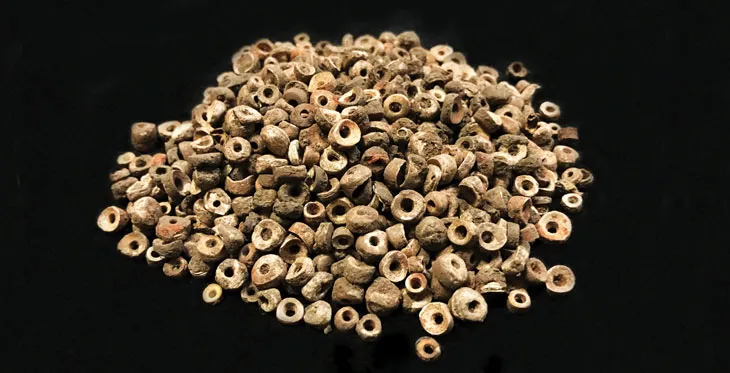
Archaeologist Lynn Gamble of the University of California, Santa Barbara presented a case for that scenario in April.
“Chumash shell money was made in large quantities on the Channel Islands, which lacked many resources available on the mainland,” Gamble says. Channel Islanders probably plunked down currency in exchange for marriage partners as well as various goods, such as bird feathers for ritual outfits, she proposes.
Chumash people used various beads for decoration and trade long before they turned cup-shaped beads into money, Gamble says. Excavations at Chumash sites have unearthed beads made of stone, bone and seashells that date to more than 8,000 years ago. Those beads weren’t distributed in large quantities throughout settlements as was typical of later beads used as money, Gamble explains.
Shell money beads appeared much later, she says. At that time, heaps of these shell beads carved in cuplike shapes appear in many households. Shell money was also scattered in Chumash cemeteries and placed in graves. Beads treated as money didn’t emerge until Chumash settlements of that time reached populations of 800 to 1,000 people. Groups of that size needed a standard currency to simplify a growing number of economic exchanges, Gamble suspects.
From the beginnings of shell money, Chumash commoners were probably always in debt to chiefs and their assistants, Gamble adds. Spanish accounts from the late 1700s describe feasts organized by Chumash chiefs, where workaday folk were expected to bring food, shell money and other valuables to pay for the event and give to leaders as tribute.
Chumash people primarily bought and sold goods with their marine currency, which coexisted with longstanding trade practices. Once shell money developed a following, it was probably included in debt payments to chiefs, Gamble suspects.
Whether or not Chumash money owes more to economic exchanges than to chiefly debts, an even bigger puzzle remains. Some ancient societies, such as the Inca and earlier empires based in the Andes, kept meticulous accounting records about all sorts of goods and tribute, but had no money. Gamble says researchers don’t know why money developed in the Chumash people’s relatively simple, hunter-gatherer society and not, say, in the early 16th century Inca state.
In the ancient world, money talked in some places and never uttered a word in others.
